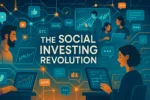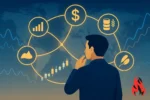The phenomenon of social investing, where retail traders congregate on platforms like Reddit’s WallStreetBets to coordinate their trading activity, exploded into the mainstream consciousness with the meme stock frenzy of 2021. While often dismissed as a chaotic and purely speculative endeavor, the social investing movement has matured significantly. In 2025, it has evolved from a simple cultural phenomenon into a sophisticated ecosystem with its own tools, strategies, and platforms. This new form of collective market participation is challenging the traditional, top-down model of financial information and creating a powerful new force in the market.
From forums to integrated platforms
The first wave of social investing was fragmented, taking place across disparate forums, chat rooms, and social media platforms. In 2025, the industry has seen the rise of integrated social trading platforms that combine the community aspects of a social network with the execution capabilities of a brokerage.
On these platforms, users can follow top-performing traders, view their portfolios in real-time, and read their market analysis. The most popular feature is “copy trading,” which allows a user to automatically mirror the trades of an experienced trader they trust. This creates a powerful new model for knowledge transfer, allowing novice investors to learn from and benefit from the expertise of seasoned market participants.
The power of crowd-sourced due diligence
One of the most powerful and often underestimated aspects of the social investing community is its capacity for crowd-sourced research. While susceptible to groupthink, these communities can also act as a massive, decentralized research department. When a community focuses its collective attention on a particular company or asset, its members will pore over financial statements, listen to earnings calls, and dig up obscure information that might be missed by a single analyst.
This collaborative due diligence can uncover valuable insights and identify investment opportunities before they are widely recognized by the mainstream financial media. This approach, while less formal, shares the same goal as traditional Fundamental Analysis: to understand the true, underlying value of an asset.
The democratization of financial information
For decades, the world of high finance was characterized by information asymmetry. Institutional investors had access to expensive data terminals, teams of analysts, and direct lines to company management, giving them a significant edge over the average retail trader. Social investing is a direct challenge to this model.
It represents the democratization of financial information, where insights and analysis are shared freely and openly. While this also means the rapid spread of misinformation, it has undeniably leveled the playing field. A retail trader today has access to a far greater volume and variety of market analysis than ever before. Platforms that embrace this trend by integrating community features and educational resources are thriving.
Navigating the risks of social investing
Despite its evolution, social investing is not without significant risks. The same mechanisms that allow for crowd-sourced research can also create powerful echo chambers and fuel speculative bubbles. The herding behavior inherent in these communities can lead to massive price distortions that are disconnected from an asset’s fundamentals. The psychology of the crowd can be a powerful and dangerous force, and it is easy for an individual to get swept up in the hype and make emotional decisions.
Success in this environment requires a strong degree of skepticism and a disciplined approach to risk management. It is crucial for participants to do their own research and not blindly follow the crowd, a principle that is a cornerstone of any sound education on Trading Psychology and Risk Management. Modern trading platforms can help by providing advanced charting tools and access to a wide array of markets, allowing traders to verify the claims made in social forums against real market data.



